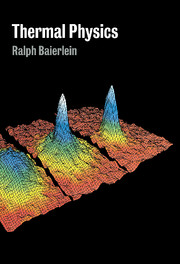Book contents
- Frontmatter
- Contents
- Preface
- 1 Background
- 2 The Second Law of Thermodynamics
- 3 Entropy and Efficiency
- 4 Entropy in Quantum Theory
- 5 The Canonical Probability Distribution
- 6 Photons and Phonons
- 7 The Chemical Potential
- 8 The Quantum Ideal Gas
- 9 Fermions and Bosons at Low Temperature
- 10 The Free Energies
- 11 Chemical Equilibrium
- 12 Phase Equilibrium
- 13 The Classical Limit
- 14 Approaching Zero
- 15 Transport Processes
- 16 Critical Phenomena
- Epilogue
- Appendix A Physical and Mathematical Data
- Appendix B Examples of Estimating Occupation Numbers
- Appendix C The Framework of Probability Theory
- Appendix D Qualitative Perspectives on the van der Waals Equation
- Index
Preface
Published online by Cambridge University Press: 05 June 2012
- Frontmatter
- Contents
- Preface
- 1 Background
- 2 The Second Law of Thermodynamics
- 3 Entropy and Efficiency
- 4 Entropy in Quantum Theory
- 5 The Canonical Probability Distribution
- 6 Photons and Phonons
- 7 The Chemical Potential
- 8 The Quantum Ideal Gas
- 9 Fermions and Bosons at Low Temperature
- 10 The Free Energies
- 11 Chemical Equilibrium
- 12 Phase Equilibrium
- 13 The Classical Limit
- 14 Approaching Zero
- 15 Transport Processes
- 16 Critical Phenomena
- Epilogue
- Appendix A Physical and Mathematical Data
- Appendix B Examples of Estimating Occupation Numbers
- Appendix C The Framework of Probability Theory
- Appendix D Qualitative Perspectives on the van der Waals Equation
- Index
Summary
Several aims guided me while I wrote. My first goal was to build from the familiar to the abstract and still get to entropy, conceived microscopically, in the second chapter. I sought to keep the book crisp and lean: derivations were to be succinct and simple; topics were to be those essential for physics and astronomy. From the professor's perspective, a semester is a short time, and few undergraduate curricula can devote more than a semester to thermal physics.
Modularity was another aim. Instructors' tastes vary greatly, and so I sought maximal flexibility in what to teach and when to cover it. The book's logical structure is displayed in figure P1. Chapters 1 to 3 develop topics that appear in the typical fat textbook for introductory physics but are rarely assimilated by students in that course, if the instructor even gets to the topics. Thus the book presumes only an elementary knowledge of classical mechanics and some rudimentary ideas from quantum theory, primarily the de Broglie relationship p = h/λ and the idea of energy eigenstates.
A benefit of modularity is that one can study chapter 13—the classical theory—any time after chapter 5. I placed the classical theory so far back in the book because I think students should get to use the quantum machinery of chapters 4 and 5 on some important physics before they face the development of more formalism.
- Type
- Chapter
- Information
- Thermal Physics , pp. xi - xivPublisher: Cambridge University PressPrint publication year: 1999



